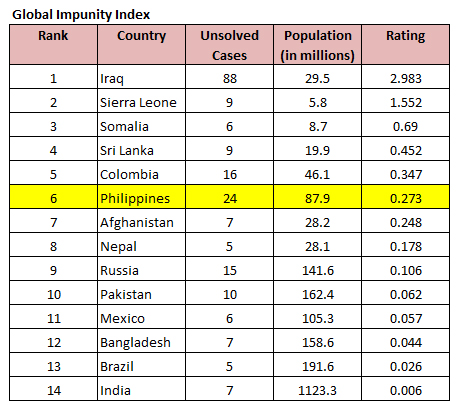By YVONNE T. CHUA
FOUR years after Mindanao journalist Marlene Garcia Esperat was gunned down on Good Friday inside her home in Tacurong City, her assassins have been convicted—but not the masterminds who have been identified and charged in court but have yet to be arrested.
This despite the issuance of arrest warrants against the masterminds, Department of Agriculture regional officials Osmena Montaner and Estrella Sabay, first on Feb. 4 last year by a Cebu City court and then on Oct. 21 by the Tacurong City regional trial court.
Meanwhile, unsure of getting a fair trial in Tacurong City, the Freedom Fund for Filipino Journalists, which consists of six media organizations providing legal assistance to the families of slain journalists like Esperat, asked the Supreme Court last Feb. 19 to transfer the case against Montaner and Sabay to Makati.
The Esperat murder case is “emblematic” of the unsolved killings of journalists in the Philippines, according to the New York-based Committee to Protect Journalists which timed the launching of the 2009 Global Impunity Index on the eve of her fourth death anniversary Monday.
For the second year in a row, the Philippines made it to the top countries in the Global Impunity Index, which calculates the number of unsolved journalist murders as a percentage of a country’s population. The CPJ defines unsolved cases as those that have not resulted in convictions.
 Like last year, the Philippines ranks sixth in the list of 14 countries, having recorded 24 unsolved journalist murders from Jan. 1, 1999 to Dec. 31, 2008. Seven journalists were killed in the line of duty in the Philippines last year.
Like last year, the Philippines ranks sixth in the list of 14 countries, having recorded 24 unsolved journalist murders from Jan. 1, 1999 to Dec. 31, 2008. Seven journalists were killed in the line of duty in the Philippines last year.
However, unlike the top four countries in CPJ’s list—Iraq, Sierra Leone, Somalia and Sri Lanka—the Philippines is not at war but is a peacetime democracy with the legal framework to address the murders, Elisabeth Witchel, CPJ’s Impunity Campaign coordinator, said at the launching of the Global Impunity Index in Manila.
The 24 unsolved murders are the highest in peacetime democracies, according to Shawn Crispin, who is CPJ’s senior representative for Southeast Asia. “No journalist murders have received full justice,” he said, describing the Philippines as the “poster child” for the problem of impunity where slain journalists are concerned.
War-torn Iraq recorded 88 murders from 1999 to 2008.
Witchell called on the Arroyo government to beef up the investigation and prosecution of journalist murderers, provide adequate protection to witnesses and ensure impartial venues for the cases.
“The failure to prosecute journalist murders perpetuates more violence against the press,” she said.
Witchell declared the local courts in the Philippines ineffective in handling cases of slain journalists including Esperat because, she said, they are vulnerable to influential public figures. “Justice can’t be achieved at the local level,” she said.
Esperat, a former DA personnel and a columnist for the Sultan Kudarat-based The Mildand Review and a blocktime radio broadcaster at the time of her death, had been reporting on irregularities at the agriculture department, including the procurement of fertilizers in which she implicated not only Montaner and Sabay but also then Agriculture Undersecretary Jocelyn Bolante and then National Food Authority administrator and now Agriculture Secretary Arthur Yap.
On Oct. 6, 2006, her assassins, Randy Grecia, Gerry Cabayag and Estanislao Bismanos, were convicted by the Cebu City regional trial court.
A murder case was subsequently filed against Montaner and Sabay before the Cebu court as a continuation of the proceedings, but the appellate court in Cebu ruled in May 2008 that the Visayas court had no jurisdiction over the case because, it said, it happened in Tacurong City. As a result, the murder case was refiled in Tacurong City.
The case was originally filed in Tacurong City but, on the FFFJ’s petition to the Supreme Court, was moved to Cebu. The transfer was sought after the Tacurong City court dismissed the case against Montaner and Sabay even before the prosecution had presented its evidence.
Seven other cases stemming from the killings of journalists are pending in court. The trial venues in three of these have been changed. The FFFJ and private lawyers have petitioned a change of venue in the other four cases.
Besides the Esperat case, the active cases include those of Philip Agustin of Aurora, Roger Mariano of Ilocos Norte, Rolando Ureta and Herson Hinolan of Aklan, Dennis Cuesta of General Santos, Arecio Padrigao Sr. of Gingoog City and Nilo Labares of Cagayan de Oro City.
The Arroyo administration has formed Task Force 211 under Justice Undersecretary Ricardo Blancaflor to prosecute the cases of slain journalists. Of late, however,it has limited itself to “monitoring” the cases, said FFFJ legal counsel Prima Quinsayas.
On March 11, President Arroyo ordered the police to form “tracker teams” to hunt down suspects in the killings of journalists due to renewed attacks on media persons.
The FFFJ consists of the Center for Community Journalism and Development, Center for Media Freedom and Responsibility, Kapisanan ng mga Brodkaster ng Pilipinas, Philippine Center for Investigative Journalism, Philippine News and the Philippine Press Institute.